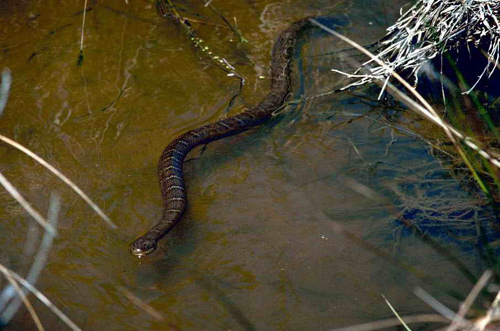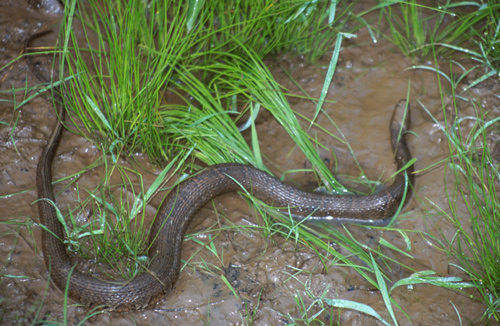Northern watersnakes can have variable coloration. Usually they have a dark brown-toned body with alternating bands of brown, reddish brown and gray. Their belly is cream with reddish half-moons. They can be 25 to 52 inches long.
The range of the northern watersnake in the US is from southern Maine to North Carolina, west to central Tennessee, north to Indiana and Illinois and west to eastern Colorado and northeast to Minnesota. They are found throughout Connecticut.
Northern watersnakes are found in aquatic and semi-aquatic habitats. They live in or near marshes, lakes and rivers. They do well in human-created waterbodies such as farm ponds, reservoirs and dams.
Mating season is around May in New England. The females give birth to 5 to 60 live young later in the summer. The babies are 6 to 10 inches long. The banding on young snakes is more visible than on older ones. They receive no maternal care.
These snakes are active during the day, but sometimes at night as well. They bask in the sun on branches or in shrubs along the banks of waterbodies. Snakes cannot regulate their body temperature internally and must warm themselves in the sun. Northern watersnakes hibernate in the winter beginning about October and emerging in April. Dens in rock crevices, old wells, muskrat houses or beaver lodges are generally used.
Northern watersnakes are active hunters and eat insects, frogs, toads, and fish. They swallow their meals whole.
Northern watersnakes are often curious and will approach people in the water or on the banks. If confronted, however, they try to run away. They can swim with their heads above water and often head for the shore opposite to a threat. They can also swim underwater, or dive and hold onto submerged debris. They can remain underwater for a long time, up to 90 minutes. Usually they only stay under about 5 minutes. Northern watersnakes will bite aggressively and frequently if caught and handled. They are not venomous. They will also produce musk and defecate.
To avoid bites, don't bother or approach snakes, and watch where you step. If you see a dangerous snake, move away slowly. They want nothing more than to be left alone.
The northern watersnake is often confused with the copperhead in Connecticut. Some people think they are water moccasins even though those venemous snakes do not live in Connecticut.

